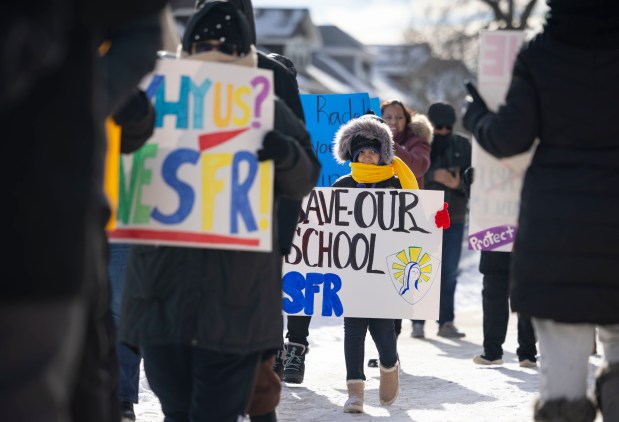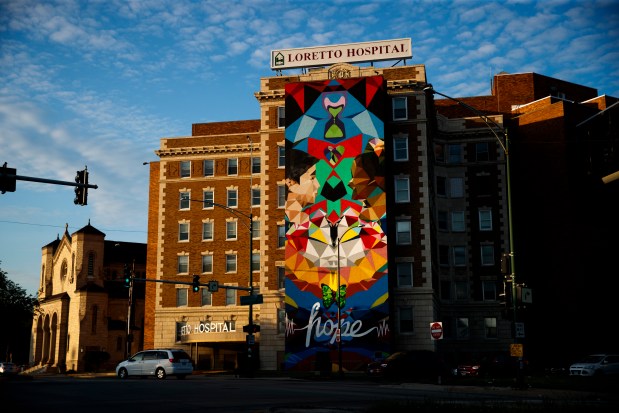When Cristina Moreno enrolled her daughter, Camila, in kindergarten last year at St. Frances of Rome in Cicero, she felt certain the school would provide a well-rounded education and social environment for years to come.
Moreno, a single mother of two from Cicero, sends Camila to St. Frances with support from the Invest in Kids tax credit scholarship program, which she called a “great help” financially.
In the fall, the expiration of the Invest in Kids program left Moreno scrambling to search for other scholarships and financial aid options to ensure that Camila, 7, and her son, Carmelo, 5, could attend St. Frances of Rome next year.
Two months later, the second punch hit when the Archdiocese of Chicago said it would be closing the school, citing a “financial cliff” following the sunset of Invest in Kids, which covered tuition for around 5,000 students across the archdiocese. Now, she’s left to search for financial help while looking at other, pricier Catholic school options.
“I’m just worried that I can’t keep them in Catholic school because I know that St. Frances was very affordable,” Moreno said. “It’s right around the block for me as well, and I’m kind of at a standstill at the moment.”
Moreno is one of many parents whose children’s educational future is in limbo following the expiration of the Invest in Kids program, and among the families, both tax credit recipients and full-tuition payers, searching for education options as at least six Catholic schools are set to close across the state.
In the fall, school choice advocates warned that privately-run religious and independent schools could be at risk of shuttering without the millions of dollars in tax credit program funds directed to them.
Signed into law in 2017, Invest in Kids provided what are effectively public subsidies in which donors could receive a 75% tax credit, capped at $1 million, on donations to private school scholarships. A handful of nonprofits process applications and distribute the aid, awarded in lump sums so students can finish out the school year.
In dioceses with schools closing, church leaders acknowledged ongoing financial struggles but said support from Invest in Kids kept the schools afloat.
Private schools across the state are encouraging, and hoping, donors will step up their giving to keep low-income students in their schools, especially as the end of Invest in Kids brought widespread attention to school choice programs.
At Chicago Hope Academy, a private Christian high school on the Near West Side, more than half of the students attend through tax credit scholarships. Hope Principal and President Ike Muzikowski said the school has committed to keeping each student enrolled, taking it upon themselves to raise the money for roughly 130 students on scholarship.
But with fewer immediate scholarships available and a potential drop in money from donors attracted by tax credits, it could just be a temporary bandage for the future challenges of Illinois’ religious schools.
“There’s long been a philanthropic investment in creating a more varied and richer landscape of quality educational opportunities, but the desire for parents to have access to that education will far outweigh the philanthropic interests,” said Josh Hale, of the Big Shoulders Fund, a Chicago-based nonprofit that distributed more than $19 million in tax credit scholarships during the 2022-23 school year to mainly Catholic school students.
Future of Catholic Schools
When the Rev. Bartholomew Juncer, pastor of St. Odilo School in Berwyn, sat in on a final archdiocesan meeting to discuss the future of four Catholic schools in Berwyn and Cicero after Invest in Kids ended, he felt torn. He believed in the school’s mission but the finances spoke louder.
“I said, ‘From my heart, I want to keep my school open and find a way to finance it. But from my head we just can’t sustain it any more,’” Juncer recalled. “The numbers are too small and losing income is too much of a burden.” On Jan. 19, St. Odilo announced plans to close its doors at the end of the current school year.
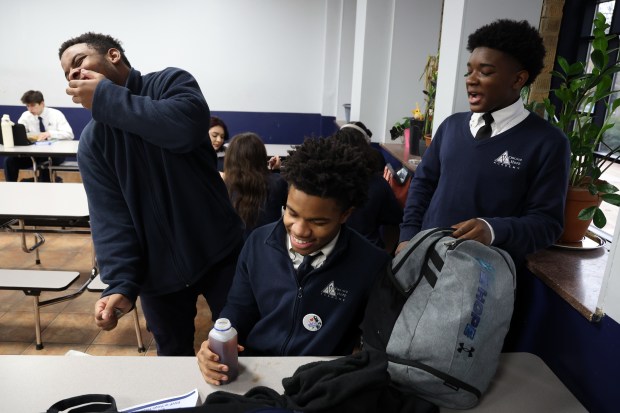
Up through the eleventh-hour effort to save Invest in Kids, Catholic school leaders focused on advocating for the program’s continuation. But once legislators failed to take up an extension of the program past Dec. 31, conversations began to take place on how schools would operate in the future, said Greg Richmond, superintendent of schools for the Archdiocese of Chicago.
More than 9,000 students attended private schools in Illinois with financial support from the tax credit scholarships during the 2022-23 school year, according to officials.
State data is not available yet for the program’s 2023-24 year, as state law requires scholarship granting organizations to provide financial information by Jan. 31 of each calendar year.
“It’s the schools who serve the greatest number of low-income students who are now going to get the biggest hit,” Richmond said. “Not a single middle-income or upper-income family lost a scholarship because they’re not eligible for them. Only low-income families had the rug pulled out from under them.”
Catholic schools closing their doors in Illinois this summer include St. Frances of Rome; St Odilo; Notre Dame Academy in Belleville; St. Ann in Nashville; and St. Paul the Apostle School and St. Jude School in Joliet. In Joliet, St. Paul and St. Jude will consolidate and operate as one school, the diocese said.
All the schools cited the loss of Invest in Kids as at least a contributing factor in the impending closures.
At the meeting Juncer attended, a decision was made based on projected budgets. With smaller student populations and higher projected deficits, the archdiocese elected to close St. Frances and St. Odilo, in hopes that one school in both Cicero and Berwyn would have a better chance to survive long-term.
The two affected schools have a combined 164 students — 104 at St. Frances and 60 at St. Odilo — attending with support from the tax credit program for the 2023-24 academic year, according to the archdiocese.
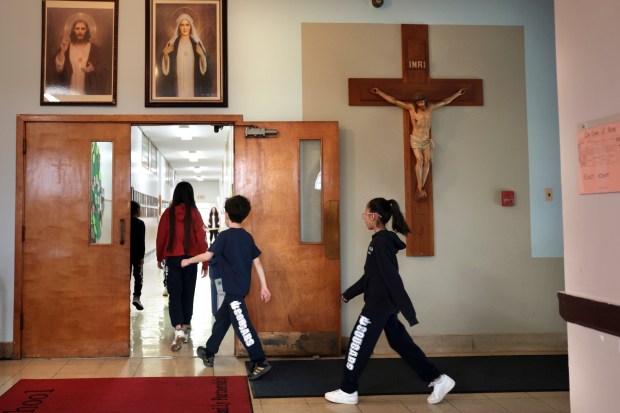
During the 2022-23 academic year, Invest in Kids funds supported 13 students attending St. Frances of Rome and 27 students attending St. Odilo, according to data compiled by the Department of Revenue. The year prior, 25 students at St. Frances of Rome and fewer than 10 students at St. Odilo received scholarships.
After a tense political year for the program, some tax credit opponents saw the connection between the increase in scholarship students to the school closing as a stretch.
“I was definitely surprised to see how many voucher students are enrolled this year at those schools because it’s really a big jump from the previous years,” said Cassie Creswell, of the advocacy group Illinois Families for Public Schools, which opposed Invest in Kids. “It raises a lot of questions, and the truth is this is a fundamental problem with the program as a whole is that there’s not the same transparency for private schools as there is for public schools.”
After compiling and reviewing the data, a spokeswoman said the Illinois Department of Revenue releases an annual report that includes the number of students in the program, how many students attend each school, and student demographics by the end of March.
Richmond said donations poured in following increased media attention last summer when state legislators did not include Invest in Kids in its budget. That trend led to a jump in Catholic school students on tax credit scholarships in what ended up being the program’s final year, he said.
Although the Invest in Kids Act required the State Board of Education to create an annual report on the learning gains of students receiving scholarships, the jury is out on the program’s results. Such a report has yet to be released, according to a spokesperson for the State Board of Education, citing COVID-19 as the source of the delay.
Invest in Kids grant money goes toward covering a student’s tuition. Student tuition covers only a portion of funds that Catholic schools need to operate, the Office of Catholic Schools said. Spending varies based on the individual school, but they rely on donations and subsidies from parishes, among other channels, to round out budgets.
A spokesperson for the Department of Revenue said due to how scholarship granting organizations aggregate data, the state can not calculate the total scholarship amount received by individual schools.
Creswell said trends showed Catholic school enrollment had been declining for years and questioned whether other factors played a larger role in the schools closing.
In 2021, the archdiocese closed four schools due to low and declining enrollment.
Richmond maintained that interest in Catholic education is strong, “but some schools are losing hundreds of thousands of dollars in scholarship funds, already running on a tight budget and are already being subsidized by their parish.”
Opponents of the voucher program say the closings represent a blind spot in oversight for institutions using public dollars.
“We don’t really have any idea for those two schools that are now going to be consolidated, what has been their financial situation over the last couple of years,” Creswell said.
A West Side school’s commitment to keeping students
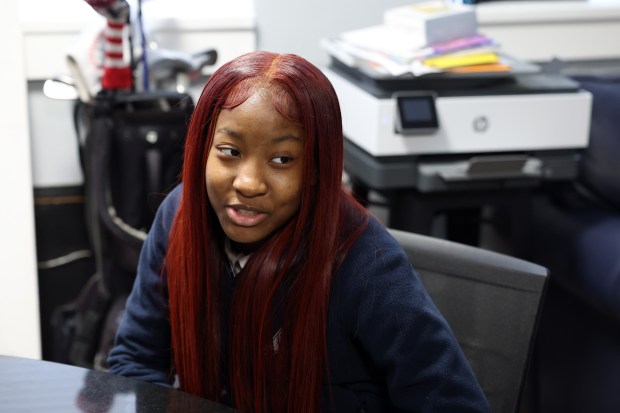
Jada Gray, a 17-year-old junior at Chicago Hope Academy, has a clear vision for her future. Graduate high school, attend college before achieving her goal of working in crime scene investigation.
After transferring to Hope in her sophomore year with support from Invest in Kids, Gray believes she has been given the help and support to confidently look toward her educational goals.
“If I went to my community high school in North Lawndale, I wouldn’t feel ready without the opportunities I have here,” she said.
At Chicago Hope Academy, half of the students are subsidized by the tax credit scholarship. Those students comprised 1.2% of all Invest in Kids scholarship recipients in Illinois during the 2022-23 school year. Even with the loss of the program, Muzikowski said the school is determined to keep current students at the school.
“It’s something that we’re reevaluating as a development team. We’re all collaborating to look into strategies for sustainability,” Muzikowski said. “We think Hope is a school within the city that Chicago can’t afford to lose.
“People really did start leaning into tax credit scholarships, so it’s not a surprise that schools supporting low-income students with these scholarships are now going to have to start shutting their doors or consolidating.”
At Hope, 97% of students are Black or Hispanic, and almost all Invest in Kids are students of color. For school choice proponents, it’s the perfect representation of how tax credit scholarships diversify private schools, but opponents say that trend is not seen statewide.
During the 2022-23 school year, no Black students received the scholarships at more than half of the schools participating in the program, and there were no Latino recipients at about a third of the schools, according to data from the Illinois Department of Revenue.
Only about a quarter of the money in the program went to low-income students, and roughly the same percentage went to students from areas with at least one low-performing public school, according to the Department of Revenue data.
Both sides said they believe it was the first time such a voucher program has been discontinued.
A spokesperson for Gov. J.B. Pritzker, who has flipped sides on the issue, said he would review any bill that reached his desk from the state legislature.
A fight to save a school
On a chilly morning in Cicero before Sunday Mass, dozens of St. Frances of Rome parents gathered outside the church to plead for the school to remain open — a request the archdiocese has said is unlikely.
“It is mostly anger and sadness because you are ripping a family apart,” said Christine Clarke, parent to a seventh grader and a graduate of the school. “It was a mix of emotions, but all of the parents are all sticking together in fighting to save the school.”
St. Frances parents say they feel blindsided by news of the school’s closure and left out of discussions on the school’s fate. Meanwhile at St. Odilo School, school leaders warned parents years ago of the declining financial state of the school.
Betty Paz, a St. Frances parent leading efforts to speak with church leaders on reversing the impending closure, said multiple anonymous sponsors have stepped up to contribute “a large amount” to save the school. But the donors are hesitant to give money until the church gives the green light and seriously considers keeping the school open.
“They gave warnings at St. Odilo for years, but not for us,” Paz said. “Why not give us three years of grace?”


